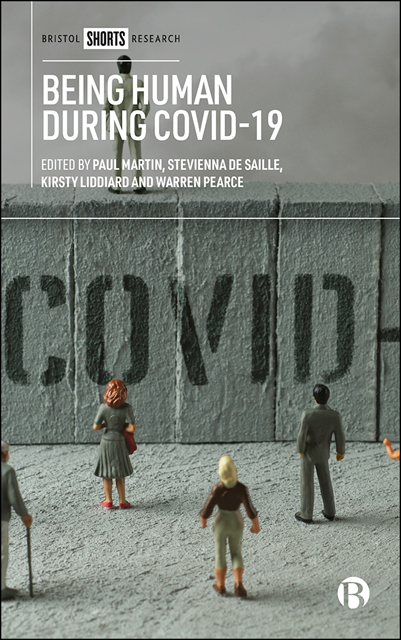three - The Role of Everyday Visuals in ‘Knowing Humans’ During COVID-19
Published online by Cambridge University Press: 13 October 2022
Summary
The human condition during COVID-19 has been communicated through a barrage of news stories about the pandemic, and much of that news has been visual. Line charts, bar charts and data visualizations have become key to public communication about the pandemic. Likewise, photographs are also used to represent the virus and illustrate the pandemic’s impact on aspects of everyday life, like working, going to school or socializing at the pub. Writing in 2020, Julia Sonnevend argued that visual representations of COVID-19 ‘are entry points for public discussion and social contestation’ (2020: 452) and, as such, would play an important role in persuading people to act responsibly. ‘Without the ability to see and relate to this crisis’, she wrote, ‘people will be unlikely to follow strict guidelines that interfere with their usual daily lives’ (Sonnevend, 2020: 452). In short, visuals have been ubiquitous and pivotal in COVID-19 communication. In this chapter, we discuss three visuals which have become iconic of the pandemic: images of the virus itself, the flatten-the-curve-line graph, and the face mask. Then, unlike Sonnevend and other writers who prioritize iconic images like these, we propose that it is also important to attend to the more generic everyday visuals of COVID-19 that circulate.
Among those visuals that have become representative of the pandemic is the ubiquitous, computer-generated image of the virus itself (Figure 3.1). In January 2020, journalists, editors, scientists and politicians needed an image that would convey COVID-19’s seriousness. When the US Centers for Disease Control and Prevention (CDC) realized how serious COVID-19 would become, one of their first public relations moves was to ask medical illustrator Dan Higgins to give the disease a ‘visual identity’. The resulting 3D image was based on scientific data, but artistic licence was also involved: the colours red, orange and yellow were chosen to alarm the public and shadows were added to make it seem more real (Fairs, 2020). Released on 31 January 2020, the image circulated around the world. It was and continues to be used in news and on social media, sometimes with tweaks to avoid copyright issues, although there were in fact none, as the CDC wanted the image to spread. By the end of the year, the image had come to visually signify the COVID-19 crisis.
- Type
- Chapter
- Information
- Being Human during COVID-19 , pp. 28 - 35Publisher: Bristol University PressPrint publication year: 2022



